Concerning the Patch [Column_Schemes & Paints]
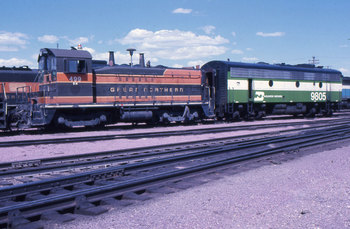 : Havre, MT, summer, 1971
: Havre, MT, summer, 1971Here is a photo of ex-GN 162, BN499, one of the 51 NW2s GN owned.
Can you see the evidence of round GN herald just beneath the white BN letters? I know the technique using scotch film to patch today. But the evidence shows that the technique of patching used on the locomotive made in 1949. I'm interested in the introduction date of the technique to the railroad industry, because I think the technique brings the expanse to the logo and herald design. I wonder if the logo and herald design changed or not after the introduction of this technique.
写っているのは、元々GREAT NORTHERN RAILWAYが51両抱えていたEMD製NW2の内の1両、162号機、1970年の合併によりBURINGTON NORTHERNの499に改番された機関車である。GNの塗色は深緑色とオレンジ色の塗り分けであるが、二色の塗り分け部分に黄色の線が入るものとないものが混在する。上は入った姿である。後年に省力化を図り、線を廃したようであるが、ないとやはりぼけた感じがする。
さて、乗務員室腰に記入された白文字BNの下にGNの円形ヘラルドを消した跡が見えるだろうか。
このGNのヘラルドは塗装などによって消されたのだろうか。見方によってはステッカーをはがしたようにも見える。最近ではロゴや機番などを、粘着シートを用いて記入するのが一般的になってきている。WESTERN PACIFICのF機の頭に粘着シートのヘラルドを貼っているところを撮った写真が表紙になっているTrains誌も見覚えがある。しかし当機は1949年製造である。もしヘラルドの記入に粘着シートが用いられていたなら、それはいつの頃からであろうか。
1930年に、粘着シートの元となるセロテープは開発されている。しかし、先に記したRio Grandeのロゴについて、テンダーにはステンシル(型板)を用いて記入したとの解説が"THE PROSPECTOR"にある。したがって、少なくとも1939年には、粘着シートを用いる技法はなかったとも考えられる。
Scotch Tape(いわゆるセロテープ)の歴史;
Flying - notes on the logo of Rio Grande 01;
われわれにもなじみ深いGNの"White Rocky logo"は1936年に制定されたようだが、筆者が粘着シート導入時期にこだわるのは、新技法が開発されると、ロゴやヘラルドのデザインの可能性が拡がると考えられるからである。粘着シートによる記入では、筆やステンシルでは困難な、細かなデザインや多色刷り・ぼかしなどのデザインが比較的簡単にできる。粘着シート導入によってどのような変化が起きたのか、あるいは起きなかったのか、筆者には興味深いところである。
Choice of rolling stock colors [Column_Schemes & Paints]
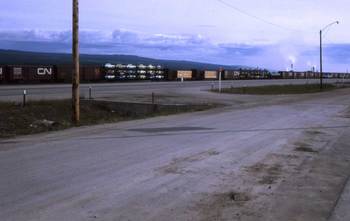 : Hinton, ALTA, Canada. summer, 1971
: Hinton, ALTA, Canada. summer, 1971I read the argument about the model manufacturer's choice of prototype rolling stock on the web: in short, manufacturers' choices are fancier[1]. I agree with that because my image for the freight train is brownish as shown in the picture above. So, I put my focus on brownish boxcars.
Many terms are used to explain the brownish color. The terms like Mineral, Oxide, Tuscan, Maroon, Brown, and Red are often used to explain the color. The most popular term maybe Boxcar Red. So, I declared it as the title of this blog.
The color Boxcar Red itself varies on occasions. Pennsylvania Railroad had original formula, Union Pacific Railroad had its own pigment quarries, and many commercial paint suppliers also produced Boxcar Red paints respectively[2]. Moreover, sun and rain weather the paint.
Anyhow, though my collection just sits in the glass case, a string of Boxcar Red boxcars looks like a realistic train for me.
revised, Sep. 30, 2022
[1] thread discussing the model manufacturer choice of rolling stock colors;
[2] B., Josh (2022) Boxcar Red, the Unanswerable Question of Our Hobby, the MRH Forum;
2010-06-29 12:59
トラックバック(0)
Durability of Paint [Column_Schemes & Paints]
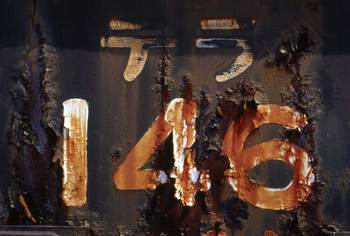 : 27 years of weathering
: 27 years of weatheringMy house needs painting every 10 years.
This JNR boxcar supposed to be last painted at least in 1985 when I took the photo in 2002. This rust represents 27 years of weathering here in Japan.
Meanwhile, we can find similar neglected boxcars in United States. In the MSCG books, we can find CB&Q 20260 built and painted in 1949 still represents its original paint in 1970 (with a little touch-up). N&W 42543 built in 1951 still wears its original costume in 1976.
So, the durability of their paints last longer than I had expected, considering my house.
Today, the Scotch patching is widely used to decorate the car. I wonder how long they will last.
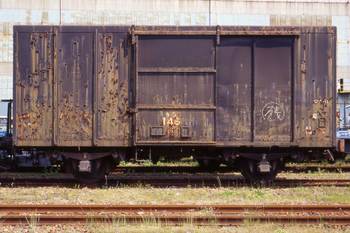 : JNR boxcar TERA146, July 2002, Osaka Japan
: JNR boxcar TERA146, July 2002, Osaka JapanGraffiti and Move [Column_Schemes & Paints]
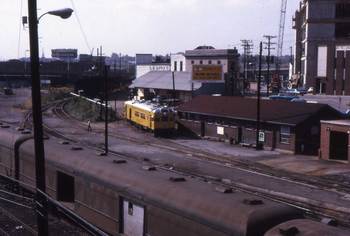 : SRS-132 and other equipment, Knoxville TN, 1970
: SRS-132 and other equipment, Knoxville TN, 1970We have many kinds of graffiti decals and weathered with graffiti cars in our hobby market, today.
I personally don't like scribbled cars. But it certainly has a kind of culture that brought, for example, Keith Haring to us.
I read on the web that the reason why the graffiti is mainly created in the United States is that the move is relatively low in the US. Indeed, equipment was almost always just tied down or standing on the rail, not running when I found them in my daily life at Knoxville.
But the New York subway which was the canvas for Keith Haring runs every some minute, 24 hours. So, the low movement would not be the reason for the graffiti.
I think its wide and plain surface and, especially, the high adhesion to the public notice induces the graffiti.
Homepage dedicated to Keith Haring;
thread discussing about the history of graffiti;
Tigers and Zebras 01 – Safety Stripes found along the Pacific rim [Column_Schemes & Paints]
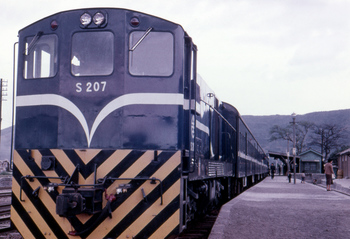 : Beitou, Taiwan. Apr. 1963
: Beitou, Taiwan. Apr. 1963Many equipment has striping on ends.
ATSF’s “Zebra Stripe” after World War Ⅱ and SP’s “Interim Tiger Stripe” in 1944 seem pioneers of end striping. But I don’t know for sure when the safety (or tiger) stripes were begun to use on equipment.
Stripe is not only used in the United States but used in many countries such as Japan and Taiwan: often seen along the Pacific Rim. In Europe, stripe seems not familiar. These facts made me think that adopting warning stripe on equipment was born in the United States.
Here are some examples of safety stripe found along the Pacific Rim.
The photo above shows the Taiwan Railway Administration’s S207, an S200 class 65t product of GM made in 1960. The photo below shows DRC1025, a DR1000 class RDC product of Nippon-Sharyo in 1998.
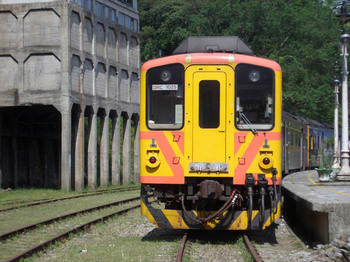 : Ching-Tung, Taiwan. Sep. 12, 2010
: Ching-Tung, Taiwan. Sep. 12, 2010Here in Japan, many switchers and industrial size locomotives used at sidings and spurs were equipped with safety stripe. The photo below shows a JNR(by then Japan Freight Railway) 10t switcher.
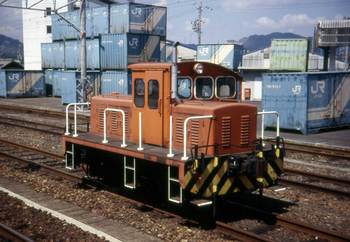 : Nakatsugawa, Gifu, Japan. Sep. 1, 1994
: Nakatsugawa, Gifu, Japan. Sep. 1, 1994The photo below shows Maruzen-Showa-Unyu’s DK605, a 20t product of Kyosan-Kogyo with a rather steep angle striping.
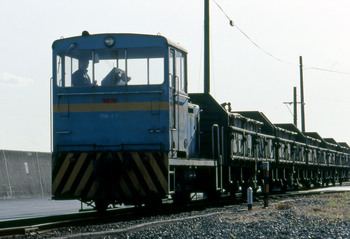 : Yokohama, Kanagawa, Japan. Feb. 9, 1994
: Yokohama, Kanagawa, Japan. Feb. 9, 1994The photo below shows Kansai-Freight-Service’s DB256 and DB254, both 25t products of Nippon-Sharyo made in 1981 and 1968 with orthodox striping.
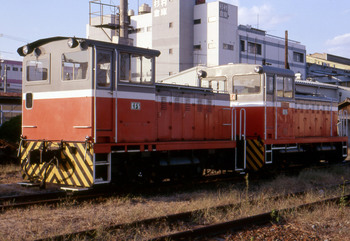 : Osaka, Japan. Feb. 2002
: Osaka, Japan. Feb. 2002And, Kanagawa-Rinkai-Railway’s DD559, a 55t product of Fuji-Heavy-Industries in 1972 also had orthodox striping.
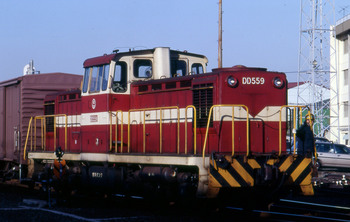 : Yokohama, Kanagawa, Japan. Feb. 9, 1994
: Yokohama, Kanagawa, Japan. Feb. 9, 19942012-08-17 09:00
コメント(0)
Tigers and Zebras 02 – Origin of the Safety Stripe [Column_Schemes & Paints]
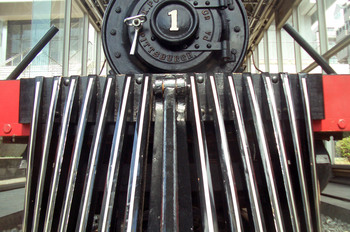 : Osaka, Japan. Apr. 4, 2012
: Osaka, Japan. Apr. 4, 2012The origin of the safety stripe on the end of equipment is uncertain. Here is my suspicious inference for the origin.
The cowcatcher was invented for safety. Purpose of stripe would also be for safety.
The cowcatcher itself might be an invention of the UK, but it got popularity in the US. And, they were found along the Pacific Rim. As I represented before, safety stripe is also found along the Pacific Rim.
The photo above shows the cowcatcher of a steam locomotive made by Porter in 1880 for use in Hokkaido Japan. It is now kept in a glass showcase at the museum. Here, we can see that the cowcatcher consists of parallel lines. Safety stripe also consists of parallel lines.
Though the blades of the cowcatcher are set parallel, it looks either spreading or narrowing out toward the end depending on from which it is viewed. It is because of its 3-dimensional curved surface of the form: It has an inclination. Safety stripe also has an inclination.
If one tries to represent the form of a cowcatcher on a plane surface, I think one would draw inclined parallel lines. Most of the safety stripe is drawn on a plane surface: the stripe on Italian locomotive (Ferrovie Nord Cargo E640) would be placed between 2D and 3D.
It seems that safety stripe was born after the cowcatcher.
From these pieces of evidence, I came to think that the safety stripe on the end of equipment was born from the cowcatcher.
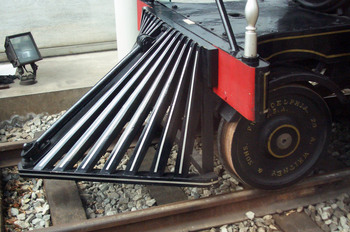 : Osaka, Japan. Apr. 4, 2012
: Osaka, Japan. Apr. 4, 2012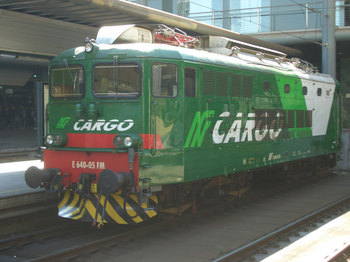 : Milano, Italy. Jun. 1, 2007
: Milano, Italy. Jun. 1, 20072012-08-24 09:00
コメント(0)
Tigers and Zebras 03 – Chevrons and Diagonals [Column_Schemes & Paints]
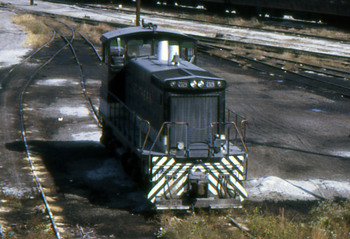 : Knoxville, TN. Winter, 1970
: Knoxville, TN. Winter, 1970One would draw inclined parallel lines to represent 3 dimensional parallel lines, such as cowcatcher, in 2 dimensions. Inclined parallel lines may make chevrons.
A way is to draw chevrons in the “upward” position. Another is to draw in the “downward” position. And the other is diagonal. Here, “downward” means the way SOU represented on SW1500, #2329 shown above. “upward” is the reverse.
SOU kept it a rule to draw chevrons downward. So as ATSF(on the front), CP, DRGW, GM&O, MEC, NKP, SAL, SCL, SP, WAB, WP, and others. CNW, CRR, MKT, NYC, PGE, RDG and others drew upward. BN, CP, and RT selected the diagonal. But, I found a weird case in Japan. Switchers of Sagami Unyu Soko adopted both upward and downward chevrons: No.1 had upward, while No.2 had downward. These switchers served U.S. Fleet Activities Yokosuka.
Most of the railroads drew 45 degrees chevrons. RDG drew steeper, and MKT drew more gently. Still more, some stripe’s width and Pitch are even, and some are not even.
Accordingly, there are so many ways to draw safety stripe on equipment. I believe that’s because cowcatcher is looked/read differently from which it is viewed.
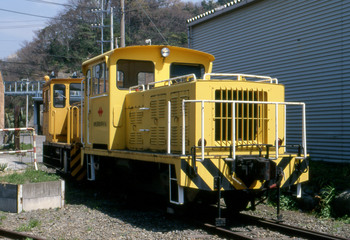 : Mar. 28, 1997 Yokosuka, Kanagawa, Japan
: Mar. 28, 1997 Yokosuka, Kanagawa, Japan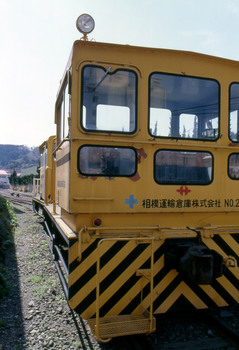 : Mar. 28, 1997 Yokosuka, Kanagawa, Japan
: Mar. 28, 1997 Yokosuka, Kanagawa, Japan2012-08-31 09:00
コメント(0)
Tigers and Zebras 04 – Safety Stripes of the North [Column_Schemes & Paints]
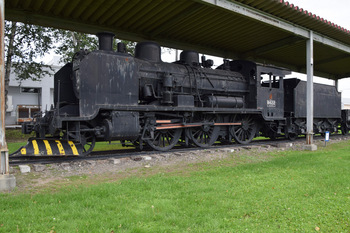 : Shikaoi, Hokkaido, Japan. Aug. 24, 2018
: Shikaoi, Hokkaido, Japan. Aug. 24, 2018I previously represented several safety stripes applied railway equipment and argued as the cowcatchers as their origin[1, 2, 3]. Here are some more stripes I found in Hokkaido, Japan this summer. There is nothing more to say for the time being: I’ll represent them here just for fun.
【北海道拓殖鉄道8622】
8622 is one of two 2-6-0 type steam locomotives built in 1928 by Kisha Seizo Co., Ltd for Hokkaido Takushoku Tetsudo. It was retired in 1960. The stripes are applied on snowplow.
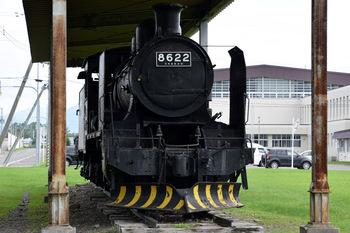 : Shikaoi, Hokkaido, Japan. Aug. 24, 2018
: Shikaoi, Hokkaido, Japan. Aug. 24, 2018【鐵原S-304】
S-304 is a 0-6-0 type steam locomotive built in 1939 by Nippon Sharyo, Ltd. for Japan Iron & Steel Co., Ltd. It is now preserved at Mikasa Railroad Village and is active. The stripes remain only on the rear end beam[4].
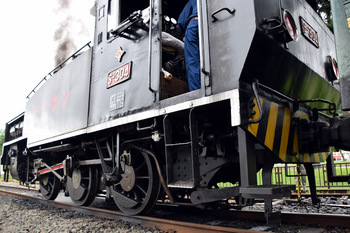 : Mikasa, Hokkaido, Japan. Aug. 26, 2018
: Mikasa, Hokkaido, Japan. Aug. 26, 2018【北海道電力2】
No. 2 is a six-wheel 25-ton diesel locomotive built in 1962 by Hitachi, Ltd. for Hokkaido Electric Power Company. It was retired in 1991. The stripes are applied on both end beams.
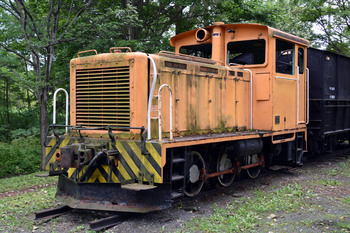 : Ebetsu, Hokkaido, Japan. Aug. 26, 2018
: Ebetsu, Hokkaido, Japan. Aug. 26, 2018【三井芦別鉄道DD501】
DD501 is a B-B 50-ton diesel locomotive built in 1964 by Fuji Heavy Industries, Ltd. for Mitsui-Ashibetsu Tetsudo. It was retired in 1989. The stripes are applied on both end beams.
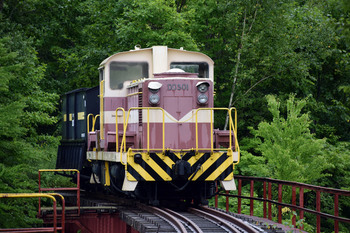 : Ashibetsu, Hokkaido, Japan. Aug. 25, 2018
: Ashibetsu, Hokkaido, Japan. Aug. 25, 2018【日本国有鉄道DD14-1】
DD14-1 is a B-B 58-ton diesel locomotive with detachable rotary snowplow head built in 1960 by Kisha Seizo Co., Ltd. for Japanese National Railway. The stripes are applied on outside of the wings.
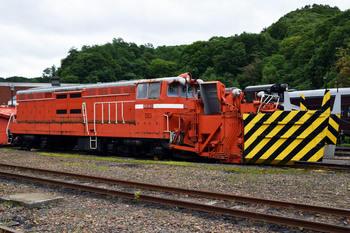 : Mikasa, Hokkaido, Japan. Aug. 26, 2018
: Mikasa, Hokkaido, Japan. Aug. 26, 2018【札幌市交通局DSB1】
DSB1 is a four-wheel 7-ton diesel snow sweeper built in 1961 by Toyohira Steel Corporation for Sapporo City Transportation Bureau. It was retired in 1971. The stripes cover the entire car body.
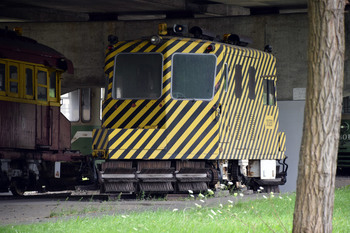 : Sapporo, Hokkaido, Japan. Aug. 28, 2018
: Sapporo, Hokkaido, Japan. Aug. 28, 2018【幌内鉄道6,しずか】
No.6 is a 2-6-0 type steam locomotive built in 1884 by H. K. Porter Co. for Horonai Tetsudo. It was retired in 1952.
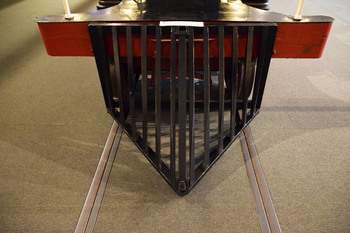 : Otaru, Hokkaido, Japan. Aug. 27, 2018
: Otaru, Hokkaido, Japan. Aug. 27, 2018【北海道炭礦鉄道30,大勝】
No.30 is a 2-6-0 type steam locomotive built in 1895 by Hokkaido Tanko Tetsudo Temiya Shop for the railroad. It was retired in 1954.
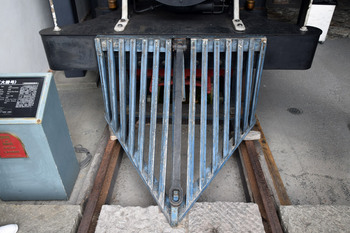 : Otaru, Hokkaido, Japan. Aug. 27, 2018
: Otaru, Hokkaido, Japan. Aug. 27, 2018【北海道拓殖鉄道8622】
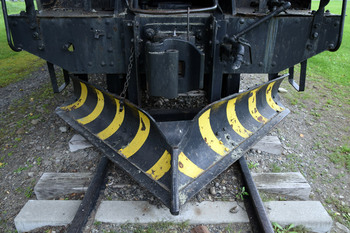 : Shikaoi, Hokkaido, Japan. Aug. 24, 2018
: Shikaoi, Hokkaido, Japan. Aug. 24, 2018[1] arx, (2012) Tigers and Zebras 01, Boxcar Red Collection;
[2] arx, (2012) Tigers and Zebras 02, Boxcar Red Collection;
[3] arx, (2012) Tigers and Zebras 03, Boxcar Red Collection;
[4] 1980 photo of S-304 with stripes applied on front beam;
2018-10-26 09:00
コメント(0)
Speed Lettering 23 − Sense of Speed caused by Effect lines, 2 [Column_Schemes & Paints]
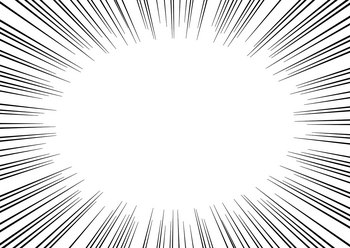 : radial MANGA effect lines
: radial MANGA effect linesIn my past post, I mentioned the sense of speed brought by “wedge shape”, “oblique position”, or “shadows or blur”, which are obviously appeared in MANGA effect lines.
MANGA effect lines are made of parallel or radial lines, as you can see above. My past post explained railroad logos referring to the effect of parallel lines. In this post, I’ll explain the railroad heralds and beyond referring to the effect of radial lines.
The significant feature of the radial MANGA effect line is that it has a void core. I recalled two railroad heralds that satisfy this condition: Union Pacific’s shield herald with wings and Gulf, Mobile & Ohio’s winged herald.
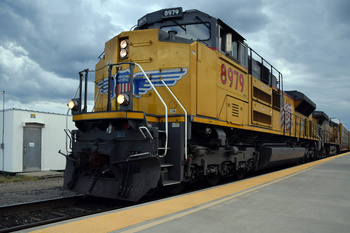 : Sep. 10, 2015. Alpine, TX
: Sep. 10, 2015. Alpine, TX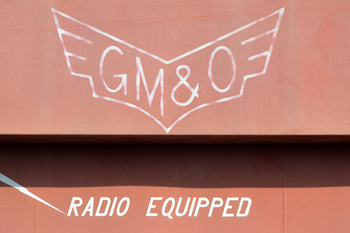 : Sep. 11, 2019. Monticello, IL
: Sep. 11, 2019. Monticello, ILUnion Pacific’s shield herald acquired wings in 1939 when EMC E3A #LA-5 was delivered from La Grange, IL.
Gulf, Mobile & Ohio predecessor Gulf, Mobile & Northern Railroad adopted its winged logo in 1935 when the railroad introduced the “Rebel” streamliner built by AC&F. The winged logo was succeeded by GM&O in 1940.
Both the heralds are first applied on the slant nose of the lead equipment. Also is that both the heralds are symmetrically applied with the ridge of the slant nose.
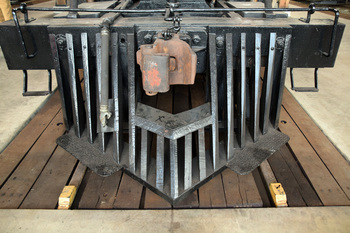 : Sugar Creek, OH. Sep. 7, 2019
: Sugar Creek, OH. Sep. 7, 2019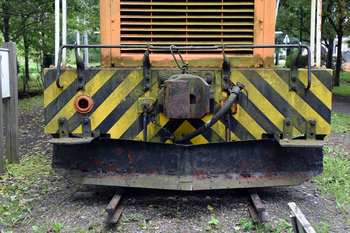 : Ebetsu, Hokkaido, Japan. Aug. 26, 2018
: Ebetsu, Hokkaido, Japan. Aug. 26, 2018Here, we can extract the terms of developing radial MANGA effect lines on railroad equipment: void core, lead, slant, and symmetry. The terms remind me of the cowcatchers and thus the safety stripes on end. They are also adopted at the lead. They lack cores but are occupied by couplers. And, they are slant and symmetrical as you see above. Therefore, I may say that the winged heralds, the cowcatchers, and the safety stripes are all the results of developing radial MANGA effect lines.
Timeline? The Chōjū-jinbutsu-giga (Frolicking Animals Handscroll/鳥獣人物戯画), the earliest drawing/manga adopting effect lines, is said to be drawn between the 12th and 16th century.
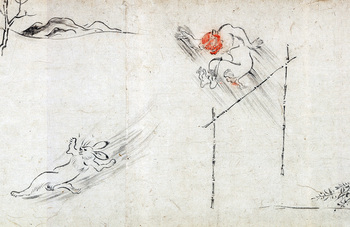 : part of Chōjū-jinbutsu-giga
: part of Chōjū-jinbutsu-giga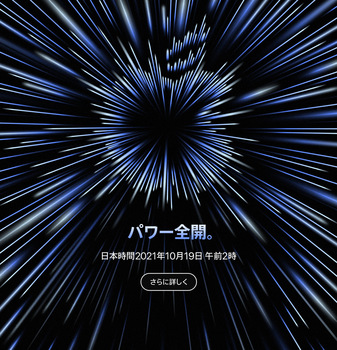 : visual for Apple Event
: visual for Apple Event 2021-09-10 09:00
コメント(0)
Tigers and Zebras 05 − Safety Stripes in the Alps [Column_Schemes & Paints]
Here are some safety stripes found in Switzerland.
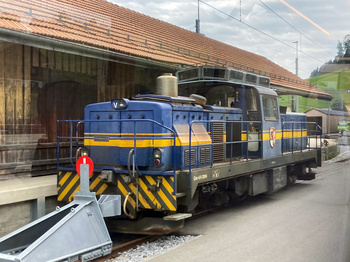 : Jul. 7, 2023 Zweisimmen, Switzerland
: Jul. 7, 2023 Zweisimmen, Switzerland
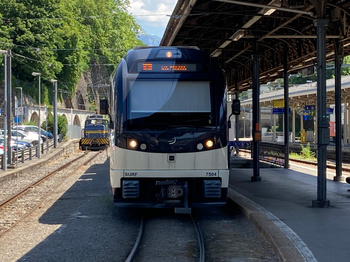 : Jul. 8, 2023 Vevey, Switzerland
: Jul. 8, 2023 Vevey, Switzerland
The top photo shows the meter-gauge Montreux Oberland Bernois Railway (MOB) diesel locomotive, and the next photo shows Transports Montreux Vevey Riviera (MVR) diesel locomotive both with chevrons on aprons.
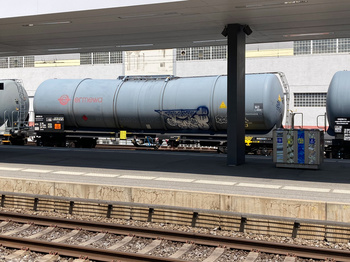 : Jul. 10, 2023 Visp, Switzerland
: Jul. 10, 2023 Visp, Switzerland
A little safety stripe is found on a passing freight train. This tank car with a safety stripe on the end of the bolster is ERSA Zacns 7841-102 (reporting mark, class, series-number) owned by the freight car rental company Ermewa.
These are the only tigers and zebras I found in Switzerland during our ten days holidays.
 : Jul. 7, 2023 Zweisimmen, Switzerland
: Jul. 7, 2023 Zweisimmen, Switzerland : Jul. 8, 2023 Vevey, Switzerland
: Jul. 8, 2023 Vevey, SwitzerlandThe top photo shows the meter-gauge Montreux Oberland Bernois Railway (MOB) diesel locomotive, and the next photo shows Transports Montreux Vevey Riviera (MVR) diesel locomotive both with chevrons on aprons.
 : Jul. 10, 2023 Visp, Switzerland
: Jul. 10, 2023 Visp, SwitzerlandA little safety stripe is found on a passing freight train. This tank car with a safety stripe on the end of the bolster is ERSA Zacns 7841-102 (reporting mark, class, series-number) owned by the freight car rental company Ermewa.
These are the only tigers and zebras I found in Switzerland during our ten days holidays.
2023-12-01 09:00
コメント(0)



